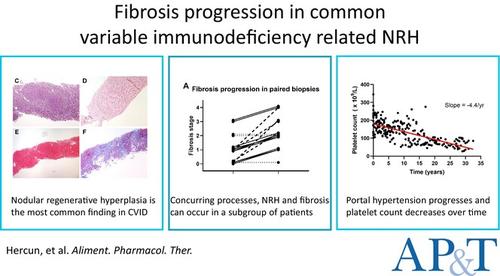当前位置:
X-MOL 学术
›
Aliment. Pharm. Ther.
›
论文详情
Our official English website, www.x-mol.net, welcomes your feedback! (Note: you will need to create a separate account there.)
Development of hepatic fibrosis in common variable immunodeficiency‐related porto‐sinusoidal vascular disorder
Alimentary Pharmacology & Therapeutics ( IF 6.6 ) Pub Date : 2024-08-02 , DOI: 10.1111/apt.18180 Julian Hercun 1 , Bilal Asif 1 , Anusha Vittal 1 , Abdel Ahmed 1 , Harish Kumar Gopalakrishna Pillai 1 , Jenna R. E. Bergerson 2 , Steven Holland 2 , Gulbu Uzel 2 , Warren Strober 2 , Ivan J. Fuss 2 , Christopher Koh 1 , David E. Kleiner 3 , Theo Heller 1
Alimentary Pharmacology & Therapeutics ( IF 6.6 ) Pub Date : 2024-08-02 , DOI: 10.1111/apt.18180 Julian Hercun 1 , Bilal Asif 1 , Anusha Vittal 1 , Abdel Ahmed 1 , Harish Kumar Gopalakrishna Pillai 1 , Jenna R. E. Bergerson 2 , Steven Holland 2 , Gulbu Uzel 2 , Warren Strober 2 , Ivan J. Fuss 2 , Christopher Koh 1 , David E. Kleiner 3 , Theo Heller 1
Affiliation

|
SummaryBackground and AimsLiver involvement is an increasingly recognised complication of common variable immunodeficiency (CVID). Nodular regenerative hyperplasia (NRH), a subgroup of porto‐sinusoidal vascular disorder, and manifestations of portal hypertension (PH) unrelated to cirrhosis are the most common findings. Nonetheless, the evolution of liver disease over time remains unknown.MethodsRetrospective review of patients followed at the National Institutes of Health with CVID‐related liver disease and liver biopsy from 1990 to 2020. Clinical, imaging and histological follow‐up were recorded as part of clinical research protocols.ResultsForty patients were included, with a median age of 37.5 years at initial biopsy, 73% presenting with clear evidence of NRH, and a median fibrosis stage of 1. At biopsy, median platelet count was 100 × 109 /L, spleen size 19.5 cm, hepatic venous pressure gradient 9.5 mmHg and 37.5% of patients had signs of PH. Cumulative incidence of PH was 65% at 5 years. In a subgroup of 16 patients, a follow‐up liver biopsy, performed at a median time of 3 years after the index biopsy, revealed an increase in fibrosis by ≥2 stages in 31% of cases and an increase to an overall stage of 2.2 (p = 0.001). No clinical or histological factors were associated with progression of fibrosis.ConclusionsIn this CVID cohort, NRH is the most common initial histological finding; however, unexpectedly fibrosis progresses over time in a subgroup of patients. A better understanding of the underlying causal process of liver disease CVID might lead to improved outcomes.
中文翻译:

常见变异性免疫缺陷相关门窦血管疾病中肝纤维化的发展
摘要背景和目的肝脏受累是常见变异型免疫缺陷 (CVID) 的一种日益受到认可的并发症。结节性再生性增生(NRH)是门窦血管疾病的一个亚组,以及与肝硬化无关的门静脉高压(PH)表现是最常见的发现。尽管如此,肝病随时间的演变仍不清楚。方法对美国国立卫生研究院 1990 年至 2020 年期间患有 CVID 相关肝病并进行肝活检的患者进行回顾性分析。临床、影像学和组织学随访记录为研究的一部分临床研究方案。结果纳入了 40 名患者,初次活检时的中位年龄为 37.5 岁,73% 的患者有明确的 NRH 证据,中位纤维化阶段为 1。活检时,中位血小板计数为 100 × 10 9 /L,脾脏大小19.5 cm,肝静脉压力梯度9.5 mmHg,37.5%的患者有PH征象。 5 年时 PH 的累积发生率为 65%。在 16 名患者的亚组中,在索引活检后平均 3 年进行的随访肝活检显示,31% 的病例纤维化增加 ≥2 个阶段,总体阶段增加至 2.2 ( p = 0.001)。没有临床或组织学因素与纤维化进展相关。结论在该 CVID 队列中,NRH 是最常见的初始组织学发现;然而,出人意料的是,一小部分患者的纤维化随着时间的推移而进展。更好地了解肝病 CVID 的潜在因果过程可能会改善结果。
更新日期:2024-08-02
中文翻译:

常见变异性免疫缺陷相关门窦血管疾病中肝纤维化的发展
摘要背景和目的肝脏受累是常见变异型免疫缺陷 (CVID) 的一种日益受到认可的并发症。结节性再生性增生(NRH)是门窦血管疾病的一个亚组,以及与肝硬化无关的门静脉高压(PH)表现是最常见的发现。尽管如此,肝病随时间的演变仍不清楚。方法对美国国立卫生研究院 1990 年至 2020 年期间患有 CVID 相关肝病并进行肝活检的患者进行回顾性分析。临床、影像学和组织学随访记录为研究的一部分临床研究方案。结果纳入了 40 名患者,初次活检时的中位年龄为 37.5 岁,73% 的患者有明确的 NRH 证据,中位纤维化阶段为 1。活检时,中位血小板计数为 100 × 10 9 /L,脾脏大小19.5 cm,肝静脉压力梯度9.5 mmHg,37.5%的患者有PH征象。 5 年时 PH 的累积发生率为 65%。在 16 名患者的亚组中,在索引活检后平均 3 年进行的随访肝活检显示,31% 的病例纤维化增加 ≥2 个阶段,总体阶段增加至 2.2 ( p = 0.001)。没有临床或组织学因素与纤维化进展相关。结论在该 CVID 队列中,NRH 是最常见的初始组织学发现;然而,出人意料的是,一小部分患者的纤维化随着时间的推移而进展。更好地了解肝病 CVID 的潜在因果过程可能会改善结果。
















































 京公网安备 11010802027423号
京公网安备 11010802027423号